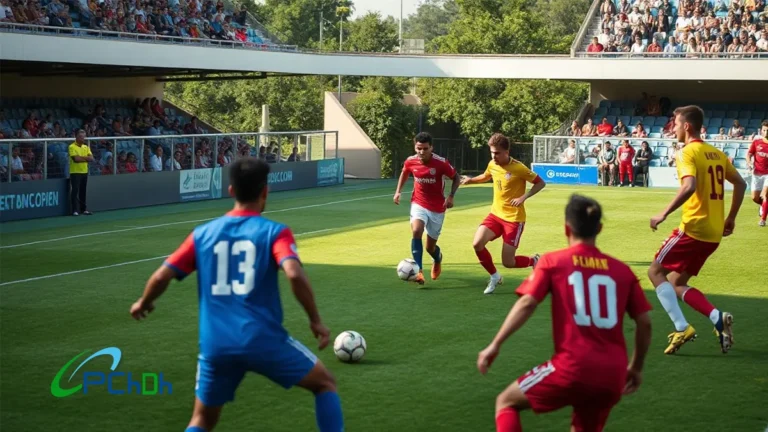Understanding how to Teamwork in Soccer and move is key to winning matches. When players get the soccer tactics right and work seamlessly together, it’s like watching a well-oiled machine in action. The best teams don’t just have talented players—they excel at teamwork and smart tactics. Knowing what to look for makes a huge difference, whether you’re coaching, playing, or just a big fan. In this guide, we’ll cover the core ideas behind soccer tactics, how teams build chemistry, and practical tips to improve your grasp of the game.
Understanding Soccer Tactics: The Foundation of Winning
What Are Soccer Tactics?
Tactics are the plans teams use to win the game. It’s about how players position themselves, how they pass, and how they block the opponent. Good tactics help players play to their strengths and cover each other’s weaknesses. They shape how games unfold and often decide the outcome more than raw talent alone.
Common Soccer Tactics Explained
- Possession-Based Play
Some teams, like Barcelona during Pep Guardiola’s era, focus on keeping the ball. They pass smoothly to control the game and tire out opponents. It’s about patience and precision. - Counter-Attacking Strategies
Other teams rely on speed and quick breaks. Leicester City’s miracle Premier League win in 2015-16 was built on fast counters, catching opponents off guard and scoring in moments. - High Press and Pressing Systems
Liverpool under Jurgen Klopp uses aggressive pressing. They hound opponents high up the pitch to force mistakes and regain possession quickly. - Defensive Organization and Low Blocks
Some teams pack the back with many defenders, sitting deep. This approach makes it tough for attackers to find space and score, often forcing the game into a grind.
Tactical Formations and Their Significance
Formations are the shape of the team on the field. Popular setups like 4-4-2 or 4-3-3 influence how players move and attack. Each formation has strengths and weaknesses, helping teams suit their game plan. Coaches may switch formations during matches—say, moving to a more attacking 3-5-2 when needed.
Analyzing Tactics Through Data and Video
Using stats and video footage makes tactics clearer. Tools like WyScout or Sportscode reveal patterns—like where a team loses the ball or how often they press. Coaches and analysts break down footage to improve strategies, and players can watch themselves to refine their game.
Building Effective Teamwork in Soccer
The Importance of Team Chemistry
Winning depends on trust and clear communication. When players know each other well, the game feels smoother. Think of FC Barcelona’s “tiki-taka”—their success stemmed from incredible team chemistry and understanding.
Roles and Responsibilities on the Field
Every player has a job. Defenders protect the goal, midfielders control the game, and forwards aim to score. Knowing where everyone should be keeps the team organized and makes coordinated plays easier. A well-structured team creates space and opportunities.
Developing Team Strategies and Cohesion
- Training Drills
Exercises that focus on passing, movement, and communication build trust. For example, small-sided games force players to think fast and work together. - Leadership and Captaincy
A strong captain guides the team, keeps spirits high, and reminds everyone of their roles. - Shared Objectives
Agreeing on game goals and understanding your team’s plan keep everyone working toward the same target.
Recognizing and Promoting Off-Field Team Dynamics
Team chemistry isn’t just about what happens on the pitch. Building a good culture and morale boosts performance. Dealing with conflicts calmly, staying positive, and supporting teammates create a stronger unit. Germany’s 2014 World Cup win shows how united teams can overcome tough times.

Practical Insights for Players and Coaches
Communicating Effectively During Play
Talk often, but also read body language. Quick signals and clear calls help improve decision-making in tight situations.
Implementing Tactical and Teamwork Training
Use drills that mimic game scenarios. For example, set-piece practice or quick passing exercises sharpen tactical understanding. Trust-building exercises like team challenges boost bonding.
Adjusting Tactics and Team Strategies
Stay alert during matches. Recognize if the opponent is weak on the wing or if pressing isn’t working, then change your plan in real time. Being flexible can be the edge in close games.
Utilizing Technology and Analytics
Tools like WyScout or Sportscode help teams analyze their performances deeply. Data reveals what works and what doesn’t. This info drives smarter training and tactics modifications.
Conclusion
Mastering soccer means understanding and applying tactics while fostering teamwork. Both elements are essential for success on the field. The game is always changing, so continuous learning and adaptation are key. Keep reviewing game footage, practicing smart plays, and communicating well with teammates. This will sharpen your skills and bring out the best in your team. Remember, consistent effort to analyze and improve makes perfect soccer strategy. Start today—study your team, learn tactics, and build strong chemistry for a winning edge.


